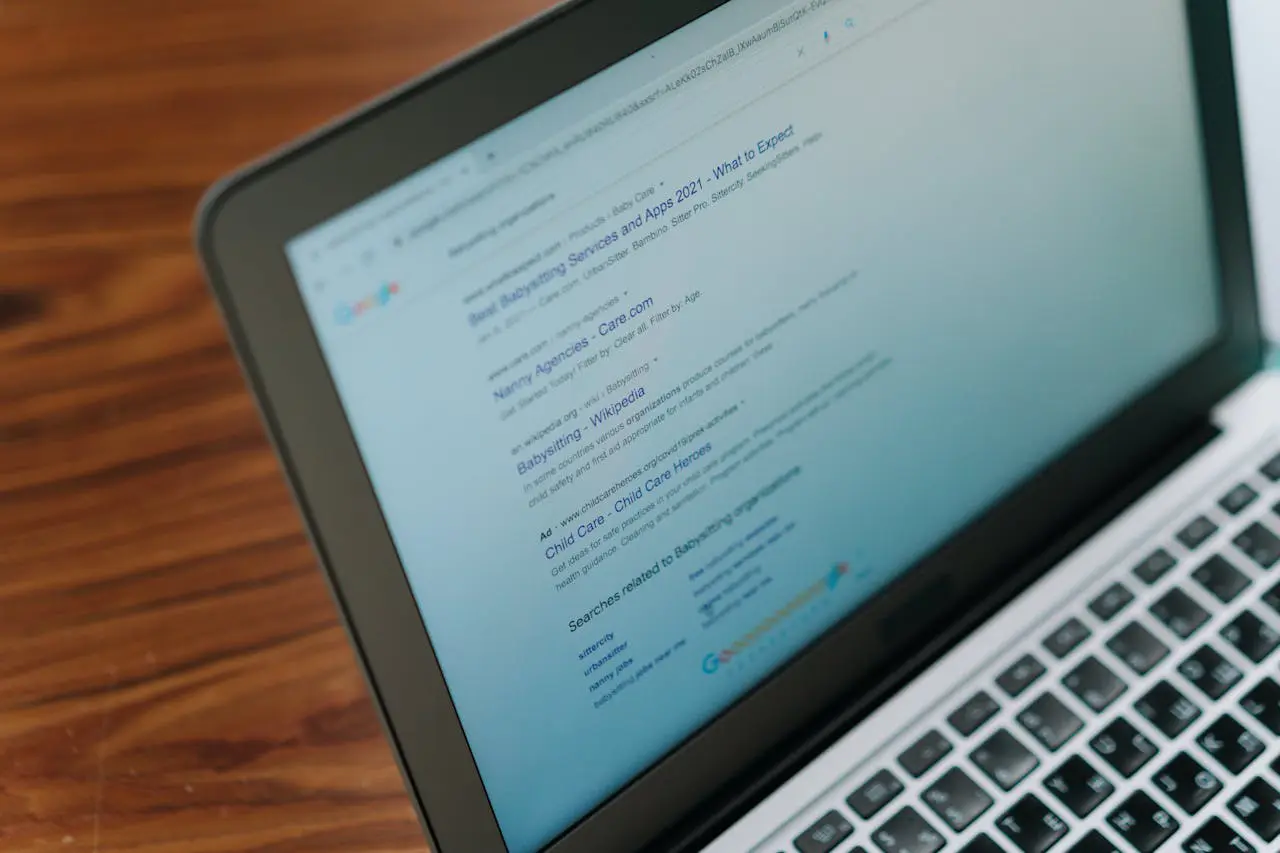In an era where our online search findings significantly influence our decisions, it’s crucial that your website is easily found.
After all, if it doesn’t appear in search results, does it really exist on the Internet?
Consider this: Over 8.5 billion searches are made on Google each day. Being absent from these search results means missing out on potential customers, visitors, and opportunities.
That’s why it’s paramount to know how to get your website to show up on Google and what to do if Google is not showing specific web results. Stay with us as we unravel the intricacies of web visibility and find out why Google might not be showing your website in its search results.
Common Reasons for Google Not Displaying Web Results
So, you’ve invested tireless efforts, time, and money into crafting and publishing your website (or a new webpage), but it simply doesn’t appear on Google’s radar?
There are a few common reasons why this problem occurs, including:

Location and Language Settings
As a website owner aiming to improve your site’s ranking, it’s crucial to understand how Google tailors search results based on user location and language preferences. If these settings aren’t optimized, your website might not reach the right audience.
To ensure your website is visible to the intended users, you should have:
- Accurate location data: Double-check that your website provides precise location information. This helps Google connect your content with users searching in your area.
- Language alignment: Ensure your website content aligns with the language preferences of your target audience. This is vital for attracting and retaining visitors.
Pro tip: You should also add a language attribute to the page HTML file to define the primary language of the website. This helps search engines understand your content’s language, improving its accuracy in language-specific search results.

SafeSearch Filter
Another possible reason why your website does not show in the SERPs is Google’s SafeSearch filter, designed to shield users from explicit content.
What does that mean? If SafeSearch is enabled, your website might be filtered out due to its content or keywords, leaving your target audience in the dark.
Here’s how you can resolve the SafeSearch filter issue:
- Content audit: Examine your website’s content. If it contains explicit language, imagery, or topics, consider revising them to align with SafeSearch guidelines.
- Keyword sensitivity: Certain terms might trigger SafeSearch filters. That’s why you should evaluate your keywords and adjust your content strategy accordingly.
- SafeSearch settings: Encourage your target audience to check their SafeSearch settings. Users often enable it unintentionally. Provide instructions on how to disable it if it’s blocking your content.

Google Account Issues
Yes, something as mundane as your Google account could be the reason behind your website’s invisibility. If your Google account is encountering issues like suspension or restrictions, it can severely limit the visibility of your website.
To eliminate this issue, you can check the following:
- Account health: Ensure your Google account is in good standing and try to resolve any suspension or restriction issues immediately.
- Quality content: Google prioritizes quality and relevance. Make sure your website offers valuable content to users.
- Webmaster tools: Utilize Google’s Search Console Tools to monitor your website’s status. Address any flagged issues promptly.
- Mobile compatibility: Confirm that your website is mobile-friendly, as Google prioritizes mobile-responsive sites.
- HTTPS: Implement HTTPS on your website to enhance security and boost trust with both users and Google.

Technical Website Problems
Technical issues are another big roadblock that can prevent you from ranking your website on Google. Here’s how you can ensure your site doesn’t get sidelined:
- Server errors: Frequent server errors can disrupt Google’s crawling process. Check your server logs for issues and ensure your hosting provider maintains a stable server environment.
- Indexing problems: If your web pages aren’t indexed, they won’t appear in search results. Utilize Google’s Search Console to submit a sitemap, ensuring Google can easily find and index your content.
- HTTPS/SSL certificate errors: Google values security. Ensure your website has a valid SSL certificate. This not only boosts user trust but also aligns with Google’s preferences for secure browsing.

Low-Quality or Non-Indexable Content
Low-quality or unindexed content does not perform effectively in search engine rankings. Here’s how to ensure your content stands out:
- Content quality check: Review your content rigorously. Is it informative, engaging, and free of errors? High-quality content not only ranks better but also captivates your audience.
- Indexability assurance: Even the most valuable content remains invisible if it’s not indexed. Ensure your web pages are easily discoverable and indexed by Google. Utilize Google Search Console to identify and rectify any indexing issues.
- Keyword relevance: Research and employ relevant keywords in your content. Keywords should also align with user intent as Google rewards optimized content that precisely answers search queries.

Competitive SEO Landscape
In highly competitive niches, other websites might have honed their SEO strategies to perfection, making it harder for your website to surface prominently in search results.
If you find yourself swimming in a sea of competitors, it’s time to refine your approach:
- Keyword optimization: Start by fine-tuning your keyword strategy. Research and identify long-tail keywords and niche-specific terms that your competitors might be overlooking. This way, you can focus on producing high-quality content on less competitive topics.
- Backlinks: Build high-quality backlinks from reputable sources. Collaborate with influencers or industry experts to enhance your website’s authority.
- SEO audit: Conduct a comprehensive SEO audit to identify areas for improvement. Tools like Google Analytics and Search Console can provide valuable insights.
- Stay updated: Keep a close eye on SEO trends and algorithm updates. Adapt your strategies to align with current best practices.

Algorithm Changes
Google makes regular daily or weekly updates that aren’t usually announced, and there are more significant broad core updates that happen three to four times a year, which Google does announce.
These updates can cause turbulence in search rankings, leading to some websites temporarily vanishing from search results.
To avoid your website getting caught in the waves of algorithm changes, you can:
- Stay informed: Be aware of Google’s announcements regarding major updates. Following official Google channels and reputable SEO blogs can help you stay informed.
- Adapt quickly: If your website experiences a sudden drop in rankings, don’t panic. Analyze your content, backlinks, and website structure to identify areas for improvement.
- Quality matters: Google’s algorithms often prioritize high-quality, relevant content. Ensure your web pages provide value to your audience. Regularly update and improve your content to meet evolving standards.
- Seek expertise: In times of significant ranking fluctuations, consider consulting with SEO professionals who specialize in tracking and responding to algorithm changes. They can help you recover and adapt your strategy.


Website Penalties
Websites that engage in black-hat SEO practices or violate Google’s guidelines may face penalties. Here’s what you can do in this case:
- Penalty check: Log in to your Google Search Console account and check for any manual penalties. Google will notify you if your site has violated their guidelines.
- Audit your SEO practices: Perform an SEO audit of your website to identify and rectify any black-hat or spammy SEO practices. Pay attention to issues such as keyword stuffing, unnatural backlinks, or duplicate content.
- Backlink cleanup: If you suspect that low-quality or spammy backlinks are the cause of the penalty, conduct a backlink audit and disavow harmful links.
- Submit a reconsideration request: If you’ve received a manual penalty, make the necessary fixes and submit a reconsideration request through Google Search Console. Be transparent about the changes you’ve made.

Content Duplication
Duplicate content across different web pages can confuse Google, leading to poor visibility in search results. When Google encounters identical or substantially similar content on multiple pages, it must decide which one to rank, often resulting in none of them making the cut.
Here’s what you can do in this case:
- Content audit: Begin with a comprehensive content audit. Identify and list instances of duplicate content on your website.
- Canonical tags: Implement canonical tags to indicate the preferred version of a page when duplicate content is unavoidable. This guides Google in understanding which version should be displayed in search results.
- 301 redirects: If you have multiple versions of a page that need consolidating, set up 301 redirects to redirect users and search engines to the correct webpage URL.
- Unique meta titles and descriptions: Ensure that each page has a unique title tag and meta description. These HTML elements add more context to the URL.
- Consolidate similar content: If you have multiple pages with very similar content, consider consolidating them into a single, comprehensive page. When doing this, it’s essential to decide which URL to keep as the primary one, and the others should be redirected accordingly. This not only avoids duplication issues but also enhances user experience.
- Syndication guidelines: If your content is syndicated on other websites, ensure that you follow proper syndication guidelines, such as no-indexing syndicated pages or adding a cross-domain canonical tag to your webpage that includes original content. The page that has the syndicated content should also mention and link to the original source.

URL Parameters
URL parameters are the strings of text and numbers that follow the question mark in a website’s URL (e.g., website.com/page?parameter=123). They often help filter or sort content. However, if not configured correctly, they can confuse Google’s crawlers.
To avoid this, you can check:
- Canonical tags: Implement canonical tags on pages with parameters. This signals Google the preferred version of the page and helps consolidate indexing signals.
- Robots.txt: Use the robots.txt file to block Google from crawling pages with parameters that don’t add value to your SEO efforts.
- Meta robot noindex: Noindexed pages can be crawled but won’t get indexed. This tag can be used for pages that are not meant for public search or don’t contribute to your SEO strategy. In cases where the content on a page should not be indexed, you should either block the page entirely or use the ‘noindex’ tag.
- Remove a webpage by request: Within Google Search Console, you can submit a request to remove specific webpages from your website. However, this should be done as a last resort in cases when blocking with robots, or noindexing does not work and the pages are still up.
- Clean URLs: Whenever possible, structure your URLs with descriptive, clean parameters that make sense to both users and search engines.
11Temporary Outages
Whether it’s due to server issues, maintenance, or other technical glitches, when your website faces downtime, Google’s crawlers might not find it during those moments.
Additionally, although rare, Google itself can experience outages, impacting its indexing process and temporarily affecting search results.
Here are some tips you can follow in this case:
- Monitor uptime: Utilize website monitoring tools that promptly alert you to any downtime. This allows you to address issues swiftly.
- Server health: Ensure your hosting provider maintains good server health. A reliable host minimizes downtime risks.
- Scheduled maintenance: If maintenance is required, schedule it during low-traffic hours to minimize disruptions.
- Content Delivery Networks: CDNs can help distribute website content across multiple servers, reducing the risk of downtime due to server failures.
- Error pages: Customize error pages (e.g., 404) to provide helpful information to visitors when outages do occur.
- Google outage checker: Check for any Google outages that might be impacting search results. It’s rare but not impossible.
12New Website
You’ve just launched your brand-new website with excitement. You eagerly search for it on Google, but it’s nowhere to be found. Don’t worry, this is a common hurdle for fresh websites.
Google needs time to discover, crawl, and index new websites and web pages. Until that happens, they won’t appear in search results. This delay occurs because Google’s bots have millions of websites to explore, and your new entry is in the back of the queue.
Here’s what you can do to speed up the process:
- Sitemap submission: Submit a sitemap through Google Search Console. It’s like giving Google a roadmap to your site.
- Internal links: Include internal links within your website. They help Google discover new pages.
- External links: If possible, seek backlinks from reputable websites. They act as recommendations to Google.
However, remember that there’s no instant solution. New websites need time to earn Google’s trust.
Preliminary Checks
Before diving into the complexities of why your website isn’t showing up in the SERPs, it’s wise to perform some preliminary checks. Often, the issue stems from technical glitches that can be easily rectified.

Crawler Blocking Issues
These issues could be:
- Robots.txt file: Check your website’s robots.txt file. Sometimes, in an effort to block sensitive content, you might unintentionally instruct search engine crawlers not to index your entire website.
- Robots meta tag: Similar to robots.txt, ensure that you haven’t included a noindex directive in the meta tags of your web pages. This can explicitly tell search engines to skip indexing.

Crawling and Server Problems
Check for the following:
- Server issues: Server-related problems, such as 5xx server errors or slow response times, can lead to the Googlebot dropping your web pages from its index. Hosting issues might also cause crawl rescheduling, delaying indexing.
- Webpage deletion: If you’ve deleted a webpage, perhaps due to a URL change or by mistake, it can result in a 404 error. This means the page no longer exists, and Googlebot will remove it from the index.
- Soft 404s: Sometimes, Google doesn’t recognize the 200 HTTP response status, mistakenly categorizing a page as a soft 404. This can happen due to thin content or technical rendering issues.


Rendering and Mobile Friendliness
These issues include:
- Resource blocking: Ensure that elements on your web pages (like JavaScript or CSS files) aren’t blocking the Googlebot from fully rendering your pages. This can hinder successful indexing.
- Mobile friendliness: While Google may tolerate some mobile-friendliness issues, critical problems can result in web pages or entire sections being dropped from SERPs. Ensure your site is mobile-responsive. To understand if your website is mobile-friendly, you can use Google’s mobile-friendly test tool.
Content Quality and Relevance
Have you ever wondered why some web pages excel in Google’s search results while others struggle to get noticed? One of the key factors is content quality and relevance.
But how does this work exactly?
Google is on a continuous mission to provide the best results for its users. When a webpage lacks quality content, Google might hesitate to index it. So, how can you ensure your content shines?
- High-quality content: Start by producing top-notch content that informs, entertains, or solves problems. But remember, quality alone isn’t enough.
- E-E-A-T signals: To showcase credibility, especially for topics like healthcare, consider E-E-A-T (Experience, Expertise, Authoritativeness, Trustworthiness) signals. For example, if your page discusses medical matters, ensure it’s authored or reviewed by someone with expertise in the field.
- Keyword optimization: Dive into keyword research to understand how people search for your topic. Incorporate these terms naturally into your content to improve your chances of showing up in search engine results pages.
- Competitor analysis: Study the SERPs and competing websites. Identify gaps in content and fill them with valuable information that users seek.
- SEO best practices: Adhere to SEO best practices. Optimize headings, meta descriptions, and image alt text. Create a user-friendly experience with fast loading times and mobile responsiveness.
- Backlink profile: Check your backlinks. A weak backlink profile compared to your competition could hinder your visibility.
Reach Out for Help
If you can’t resolve the issue on your own and your website still lacks visibility, you can always reach out for help.

Contact Google Support if it Seems like a Technical Issue on Their Side
If you suspect the issue might be on Google’s end, you can contact Google Support and explain the problem you’re facing. Sometimes, a glitch or misunderstanding might have occurred during indexing. Google’s support team can provide valuable insights and, if necessary, address the issue.

Seek Assistance from SEO Professionals
SEO can be a complex labyrinth. If you’re feeling overwhelmed, consider enlisting the services of SEO professionals. These experts can:
- Conduct comprehensive website audits
- Investigate issues in-depth
- Implement effective strategies to improve your website’s visibility


Join Online SEO Communities
Online SEO communities include forums, Slack channels, and other groups like:
- Women in Tech SEO
- Holistic SEO Community (Facebook group)
- BigSEO (Slack channel)
They are bustling hubs of knowledge sharing. SEO enthusiasts, professionals, and even Google employees actively participate.
Join these communities to seek advice, share your experiences, and stay updated on the latest SEO trends and algorithm changes. The collective wisdom of these groups can be a game-changer in solving SEO puzzles.
Google Results Not Showing Up FAQs
Check out the answers to some commonly asked questions related to why your website is not showing up on Google:
How Long Does It Take for Google to Index a New Webpage or Website?
Google’s indexing speed varies, primarily depending on factors like your website’s content and its overall authority.
In some cases, it might take just a few days for Google to discover and index new web pages, especially if your site is regularly updated. However, for brand-new websites or those with limited content and authority, it can take several weeks or even longer.
To expedite the process, consider submitting your sitemap through Google Search Console and regularly updating your content to signal freshness to search engines.
Why Are My Webpages Ranking Lower in Search Results Than Before?
Several factors can make your web pages rank lower in search results than before. These include:
- Shifts in Google’s algorithm, which can impact rankings
- Increased competition from other websites targeting the same keywords
- Technical issues on your own site, such as slow loading times or broken links
To address these challenges, you should regularly monitor changes in search algorithms, optimize your content, and ensure your website is technically sound.
How Can I Check if My Website is Indexed by Google?
You can easily check if your website is indexed by Google by using a simple search query. Just type “site:yourwebsite.com” (replace “yourwebsite.com” with your actual domain) into Google’s search bar.
If you see results displaying pages from your website, it means Google has indexed your site. If you don’t get any results, it might indicate that your site has not been indexed yet, and you may want to consider submitting it to Google for indexing through Google Search Console.
Why is My Website Showing in Search Results for Some Keywords but not Others?
The reason your website may appear in search results for some keywords but not others comes down to the competitiveness and relevance of those keywords.
Some keywords may have high competition, making it harder to rank, while others might be more specific or less competitive.
To improve your rankings for specific keywords, it’s essential to optimize your content around them, enhance your website’s overall SEO, and regularly monitor your performance to make necessary adjustments.
How Can I Request Reindexing of My Webpages in Google?
To request reindexing of your webpages in Google, you can use the Google Search Console’s URL Inspection tool.
This tool allows you to submit individual URLs for re-crawling and reindexing. Keep in mind that Google will still prioritize crawling based on various factors, so requesting reindexing is most effective for critical updates or new content that you want to appear in search results more quickly.
Should I Hire an SEO Professional to Address These Issues?
If SEO is crucial for your business, hiring a professional can be beneficial as they can provide expertise and save you time. Scopic Studios’s SEO experts have years of experience in the field and follow the latest trends and best practices that can help you boost your website’s visibility and rankings.
Conclusion
Maintaining a prominent presence in Google’s search results requires vigilance and adaptability.
When your web pages face invisibility, you should stay committed to producing high-quality, relevant content, adhere to SEO best practices, and keep pace with algorithm changes. Regular maintenance and monitoring are also key to enduring visibility.
If you find this process daunting, remember that Scopic Studios stands ready to be your expert guide in resolving website visibility issues on Google. With our vast SEO experience and know-how, we can help your web presence shine brighter than ever.
About Creating “Why Your Site is Not on Google” Guide
This guide was written by Veselina Lezginov and reviewed by SEO Lead Araksya Hakobjanyan.
Scopic provides quality and informative content, powered by our deep-rooted expertise in software development. Our team of content writers and experts have great knowledge in the latest software technologies, allowing them to break down even the most complex topics in the field. They also know how to tackle topics from a wide range of industries, capture their essence, and deliver valuable content across all digital platforms.























































